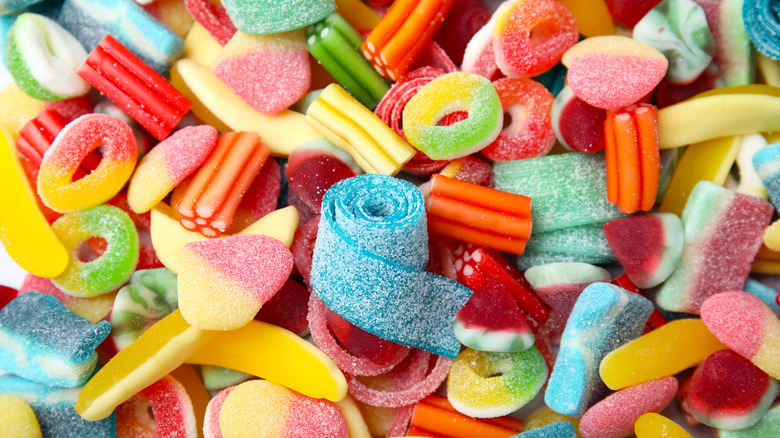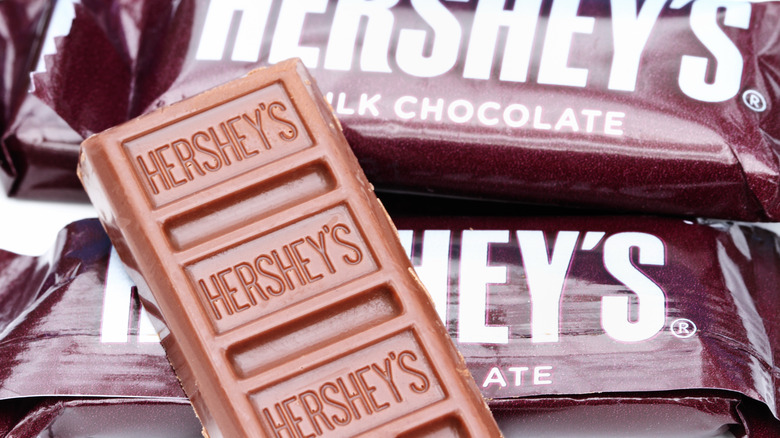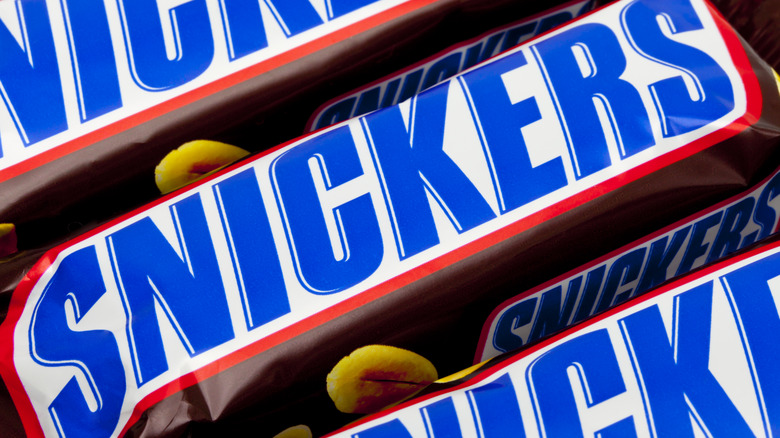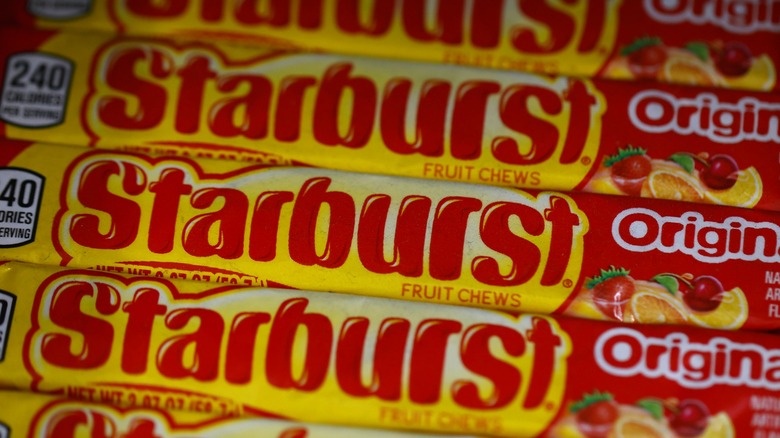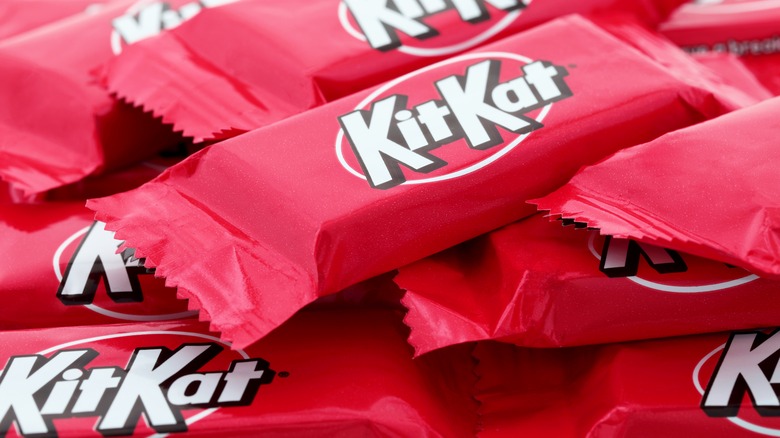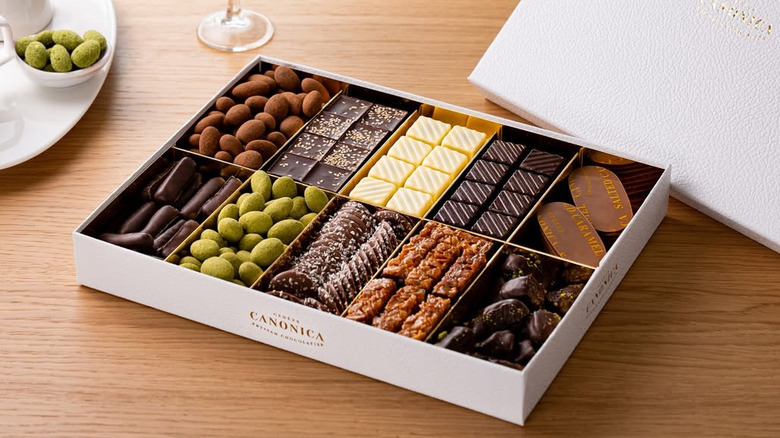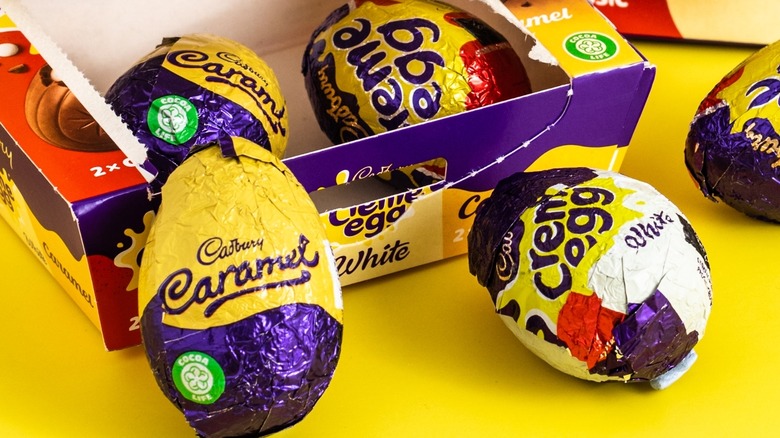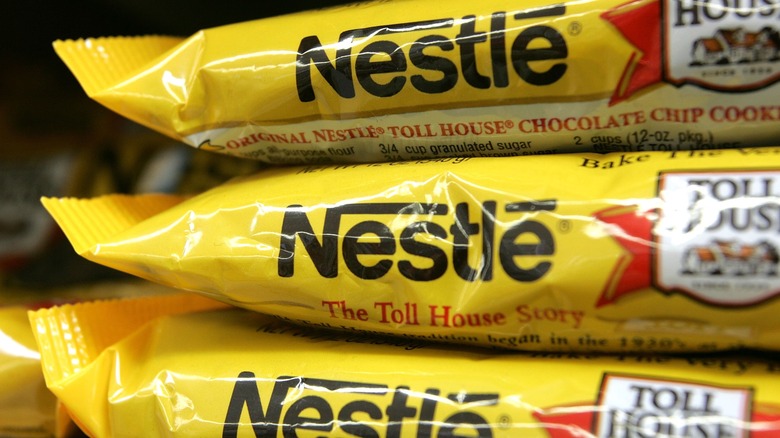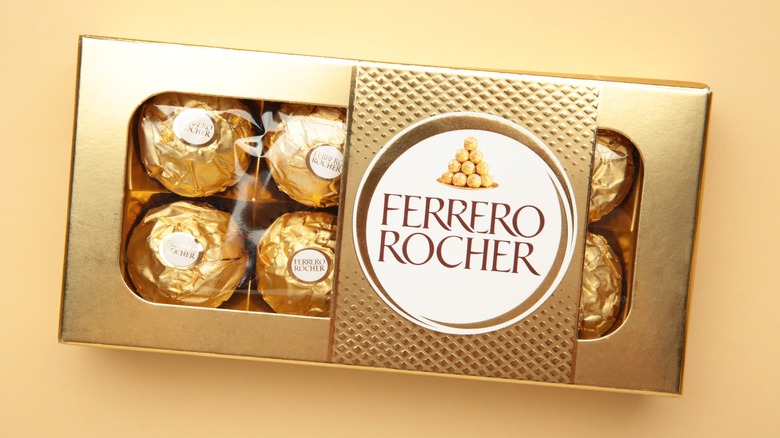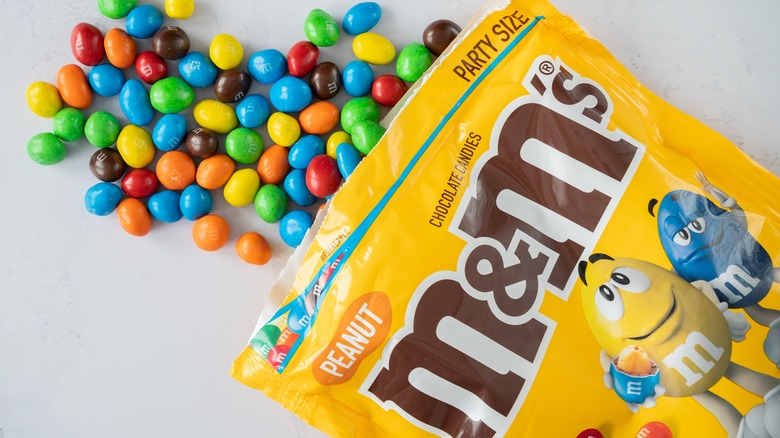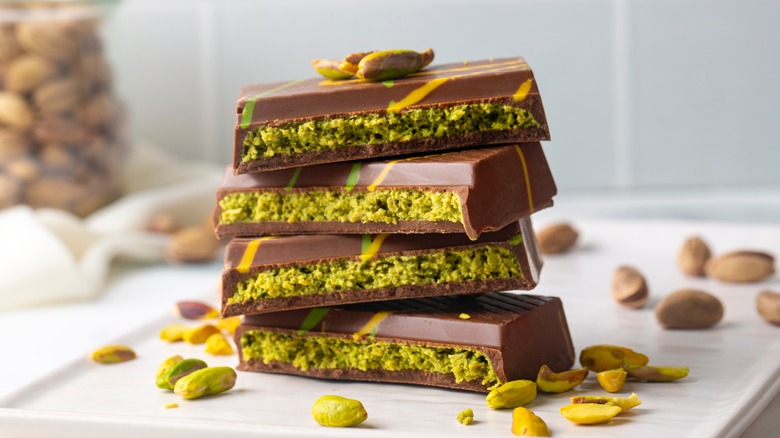10 Candies To Buy Now Before Prices Skyrocket
Have your recent grocery runs made you stop and do a double take at the price tags? If so, you're not alone. A recent study conducted by The Feedback Group found that nearly two thirds of U.S. shoppers are experiencing financial strain at the supermarket, with 61% citing rising prices as a major stressor.
Between inflation, supply chain hiccups, and the latest round of tariffs introduced by the Trump administration, Americans are finding it difficult to keep up with their grocery budgets. And no item is off limits — not even the ones in the candy aisle. You've probably heard about rising costs for more standard items like frozen foods or canned foods. But your favorite sweets? They might be next.
For the most part, that's because many iconic candy brands source staple ingredients like cocoa, sugar, or even packaging materials from countries now facing steep U.S. tariffs — with some as high as 50%. From viral favorites like Dubai Chocolate to candy store classics like Snickers and M&Ms, here are some candy brands that could potentially start costing a bit more than you're used to.
Hershey's Chocolate Bars
Hershey's is practically synonymous with chocolate in the United States, but even this iconic brand may have to raise prices soon. In May, The Hershey Company revealed that tariffs introduced by the Trump administration could lead to a $15 to $20 million expense for the company.
According to Sourcemap (a publicly accessible supply chain tracking platform), Hershey sources some of its cocoa beans from Brazil — a country which is currently facing a 50% tariff rate on imported goods if no alternative solution is reached by August 1. While media coverage has largely focused on Brazil's exports of breakfast essentials like coffee and orange juice, the country is also a major supply of key candy ingredients like cocoa and sugar. For many confectionery brands, Hershey included, that reliance could come at a steep cost.
Still, The Hershey Company has kept its cool. According to ABC 27, in a presentation on the company's first quarter of 2025, CEO Michele Buck said the company's "strong balance sheet" gives them confidence "despite heightened cost pressure."
Snickers
You may not be you when you're hungry, and you also may not be too thrilled in the checkout line if your next Snickers bar rings up with a higher price tag. Although Snickers bars are produced by Mars, Incorporated in Waco, Texas, the ingredients that make up the world's best-selling chocolate bar come from all around the world. And as global supply chains feel the pressure of higher tariffs, brands like Mars, Inc. may be forced to pass on some of those costs to consumers.
According to Sourcemap, Snickers sources sugar from Brazil, peanuts from Argentina, and chocolate from Guyana. These countries currently face U.S. tariff rates that range from the administration's baseline of 10% all the way to 50%. To put things in simple terms if you aren't an expert on international trade policy, you may have to start spending a bit extra for your favorite candy bar.
Starburst
Like Snickers, Starburst is produced in the United States but with the help of a far-reaching global supply chain. The chewy fruit-flavored candy is manufactured by Mars Wrigley: a division of Mars, Incorporated after its 2008 acquisition of the Wrigley Company.
While the Starburst ingredient list isn't overly complex, the candy relies on global sourcing for their packaging materials (including paper, plastic, aluminum) which come from countries like China and Saudi Arabia. Saudi Arabia faces the baseline tariff of 10%, but China's trade situation with the U.S. is a bit more complex.
Between the Section 301 tariff from Trump's first presidency and the more recent "fentanyl" tariff introduced in February 2025, certain Chinese imports faced a combined tariff rate of 55% earlier this year, which was then amended to 51.1% in July. But China isn't the only country that may cause Starburst to experience higher sourcing costs. According to Sourcemap, Starburst sources its sugar from the Caribbean. While the sourcing exact location in the region is unclear, the Caribbean is said to be experiencing tariffs ranging from 10% to 38%. In other words, you may have to start wishing upon a star to get some Starburst for the prices you're used to.
Kit Kat
Kit Kat's slogan may be "Have a Break, Have a Kit Kat," but when it comes to prices, customers may not be catching much of a break at all. While Kit Kat is owned by Nestlé internationally, the version sold in the United States is actually manufactured under license by The Hershey Company. That means that while the chocolate bars may share the same name, the sourcing and production may differ depending on where it's made.
In the U.S., Kit Kats rely upon ingredients sourced from all over the globe. And some of the key imports are now being with some pretty significant tariffs. According to Sourcemap, Kit Kat's supply chain includes soy from Argentina, cocoa from Ghana, palm oil from Malaysia, and vanilla from Madagascar. Those countries are currently experiencing tariff rates that range anywhere from 10% to as high as 47%.
As for that 47%? That rate is currently placed upon imports from Madagascar, a major global producer of vanilla. It's the country's main export and a crucial ingredient when it comes to Kit Kat's iconic flavor.
Canonica
Supply chain challenges aren't the only reason why you might notice higher prices on your favorite sweets. Chocolates and candies manufactured outside of the U.S. face their own set of hurdles when it comes to the recent tariffs.
Made in Geneva, Switzerland, artist chocolate brand Canonica first felt the impact during the Easter season, when a 31% tariff on Swiss imports was introduced in early April. According to AP News, Canonica's marketing manager, Julie Jammes, described the sudden tariff news as a "shock" once the news made its way to them.
For a smaller brand like Canonica that doesn't have the same resources as candy conglomerates like Mars, Inc. and Hershey, a tariff of this magnitude can be a serious blow to U.S. sales — and it shows. While the price of the chocolates themselves may not see increases, it's the shipping U.S. customers will want to watch out for. To see just how steep shipping has become, we entered our own address to calculate the cost. The result? $56.55 in shipping alone, bringing the total to $81.37 for a nine-piece assortment.
While we're not sure how much shipping costs were prior to the new tariffs, it's safe to say that Canonica won't be on our list of boxed chocolates that won't break the bank. Not to any fault of the company, of course.
Cadbury Creme Eggs
Cadbury Creme Eggs may be a seasonal treat reserved for Easter, but if the current tariffs continue to remain in place, even that more popular window might not be enough to keep eager fans in the U.S. coming back for more. Back in February, Mondelez International (owner of Cadbury, Oreo, Sour Patch Kids, among many other snack aisle staples), expressed concern about how rising tariffs could affect business.
While many Mondelez-owned brands manufacture products in the U.S. and primarily face the challenge of ingredient sourcing, others manufacture overseas. Cadbury falls into the latter category. The iconic British chocolate brand is based in London and imports its products into the United States — which means all Cadbury products will be subject to the 10% base tariff currently placed on goods.
As for what this means for American chocolate lovers? Well, this Easter favorite could soon come with a noticeably higher price tag. These days, it seems eggs still aren't affordable — not even the chocolate kind.
Toll House Chocolate Morsels
If you grew up in an "ingredient household," Nestlé's Toll House Chocolate Morsels might have been your idea of candy. But even this unconventional candy option isn't safe from price increases. According to Bloomberg, Nestlé reported that prices on Toll House chocolate morsels (along with several other products) would increase starting June 23 due to "higher commodity costs."
And based on Nestlé's own sourcing disclosures, those higher costs aren't exactly surprising. The company is relatively transparent about where its ingredients come, stating that its sugar is mainly derived from Brazil, India, Mexico, Thailand, and the United States — all of which have been hit with some pretty significant tariffs. Brazil faces the highest rate of the group at 50%, while India, Mexico, and Thailand boast rates of 26%, 25% (on non-USMCA-protected goods), and 36%, respectively.
In other words: Ingredient households beware. Because whether Toll House chocolate morsels are your go-to for homemade cookies or a midnight snack, the item's already gotten pricier.
Ferrero Rocher
You may not make a beeline to a box of Ferrero Rocher if you're on a budget — and now you may have even more reason to hesitate. Owned by the Italian-based Ferrero Group, the decadent hazelnut chocolates could soon be next in line for a bump in price.
Although Ferrero officially opened a U.S. production hub in Bloomington, Illinois in 2024, the brand (like many others) still sources ingredients from abroad. Ferrero uses both beet sugar and cane sugar in its products. The company claims the beet sugar is primarily sourced from Europe — a region currently subject to a 10% U.S. tariff — while cane sugar is imported from multiple countries, including Brazil, India, Mexico, Turkey, and Australia.
Brazil, India, and Mexico are currently facing much steeper rates (50%, 26%, and 25% on non-USMCA-protected goods, respectively). Like the European Union, Turkey and Australia are also subject to a baseline 10% tariff rate at the moment. Now, we're no trade policy expert, but it certainly seems like sourcing from Brazil could be a pretty expensive problem for the Ferrero Group. And it's possible that U.S. shoppers could end up paying the price.
M&Ms
While M&Ms is a massive brand in its own right, it's owned by an even larger company: Mars, Incorporated. The chocolate brand is manufactured in a variety of U.S. cities — including Cleveland, Tennessee and Topeka, Kansas, and Hackettstown, New Jersey. But like its Mars sibling Snickers, M&Ms still relies upon globally sourced ingredients — making it vulnerable to shifts in tariffs.
The cocoa used across Mars' portfolio of candy brands comes from 13 countries. You heard that right: 13. The primary suppliers are Côte d'Ivoire, Ghana, and Indonesia, which currently face tariff rates of 21%, 10%, and 32%, respectively.
When it comes to sugar, however, M&Ms seem to rely heavily on a single source: Brazil. According to Sourcemap, the sugar used in M&Ms is sourced from São Paulo in Brazil — a country currently facing a 50% tariff on imported goods. That makes M&Ms the fifth candy on today's list that could potentially be impacted by the soaring rate of the tariffs placed on Brazil.
Authentic Dubai chocolate
The last candy on today's list is one that's taken the internet by storm in recent months: Dubai chocolate. The problem? As the name suggests, the original version comes from Dubai — a region facing a 10% tariff on imported goods.
If you're not familiar, Dubai chocolate features a rich chocolate shell with a vibrant green pistachio and kataifi (in other words, shredded phyllo dough) filling. The viral sensation originated as the "Can't Get Knafeh of It" chocolate bar from Fix Dessert Chocolatier, a Dubai-based artisanal chocolate founded in 2021. After going TikTok viral, the bar was dubbed "Dubai chocolate," and the rest was history.
But that viral fame comes with a price. A pack of six is priced at $120 — and that's before shipping (which can cost $25 for a delivery to the East Coast). While authentic Dubai chocolate may come with a higher price tag these days, it can still be found in beloved U.S. grocery chains like Trader Joe's and Costco. And if the shelves are cleared before you get there and you have trouble finding the crunchy treat, you can always try making it yourself.

